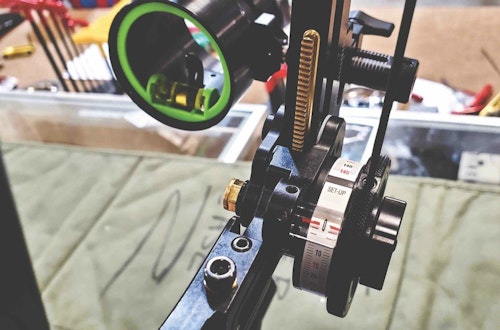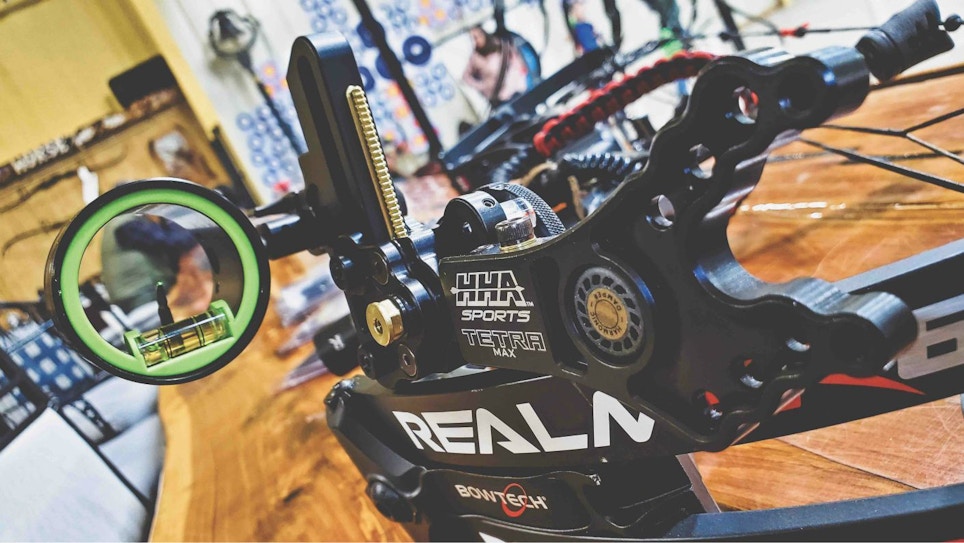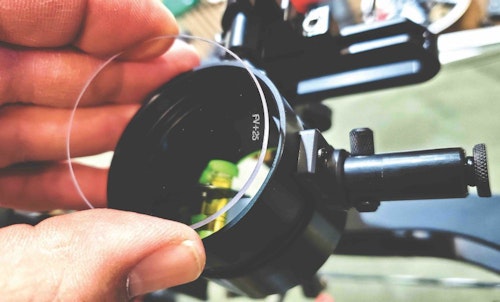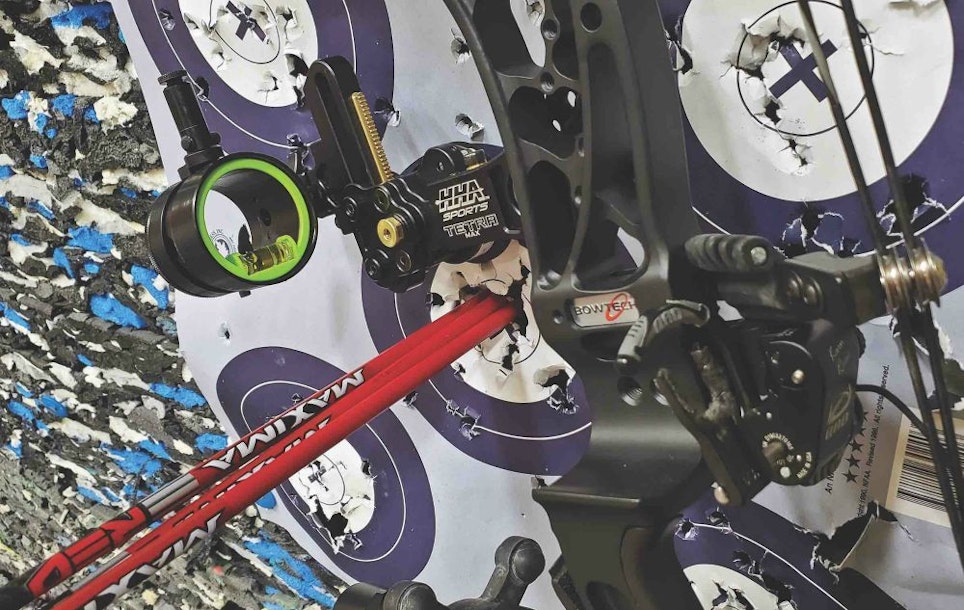Dependent of several factors, the bowsight might be the most understood or misunderstood accessory on your bow — something I’ve learned through years of experience as an archer, bowhunter and archery technician. Fortunately, one of the few additional strengths I possess is the ability to write complete sentences. What does all this mean? I get ultra-cool opportunities to play with and test a variety of archery and bowhunting equipment such as bows, sights, rests, arrows, broadheads — the list goes on. Most recently, I had the opportunity to spend quality time with HHA’s latest and greatest, the Tetra Max.
About HHA
Founded in 1984 by industry icon Harold “Harry” Hamm, HHA Sports is located in central Wisconsin. HHA Sports has dedicated over 35 years to perfecting archery sights, specifically, single-pin models. While there are exceptional single-pin bowsight manufacturers out there, there’s no question that, in the eyes of consumers, from entry-level archers and salty bowhunters to high-stakes competitive archers, that HHA has ruled the single-pin roost for quite a while — 20-plus years to be more precise, since unveiling the Optimizer in 1996.
Sadly, and to the disappointing surprise of the entire industry, Harry was called home in July 2019; however, HHA’s reputation for producing premium performing archery sights remains unscathed, customer service is still world-class, innovation hasn’t slowed one iota and the company’s determination to continue creating industry-leading single-pin sights continues. All in all, it’s quite a tribute to Harry’s legacy, and his sons and daughter — Chris, Brian and Roberta — continue to lead the HHA charge. The rest is left to a top-shelf team dedicated to our outdoor lifestyle and fiercely loyal to the family business, and the proof can be found throughout HHA Sports’ product line, especially the King Pin, now a few years old, and the brand new Tetra Max, under review right here, right now.
The Walk-Around
HHA launched the Tetra series of bowsights early in 2019; however, not one to sit back on its haunches, HHA immediately set out to improve their already solid, brand-worthy Tetra foundation. The result of tedious, feedback-centered product development was unveiled at the 2020 ATA Show and aptly named the Tetra Max. As one would expect from HHA as a premier producer of premium single-pin sights (or sights in general), the Tetra Max boasts a wheel-forward design for easier quiver installation and is constructed of aircraft-grade aluminum, as well as brass rack and pinion components for butter-smooth micro-adjustability, and an ultra-bright fiber-optic pin.
The Tetra Max also includes a dampener in the mounting bracket, and additional features like a magnifying lens and blue-burst sight light also are available. As a nighttime bowhunter of feral hogs, the benefit of a sight light specifically designed to illuminate only the fiber optic cable, can’t be overstated. The model I tested did include the Blue Burst rheostat sight light, .010 pin size, extra distance adjustment wheel and 2X magnifier lens. For adjustment, the Tetra Max is rich in both macro- and micro-adjustability across all three axes.
Laying the Groundwork
A new bowsight, especially one rich in adjustability, can be a blessing — or a curse. Either way, initially, how a sight functions after installation often has little to do with the bowsight itself and nearly everything to do with bow setup, including proper tuning. I’ve mentioned this dynamic before concerning taxing and hindering your bow sight performance before you ever launch your first arrow.
In fairness to my review of the HHA Tetra Max, my work with the sight began solely with work on the bow. For this review, I returned to my Bowtech Realm SR-6. I have it set at 70 pounds (maxed out at 71.4 to be precise) with a 27-inch draw length — yes, I have stubby arms — I was born this way.
I no longer have the lion’s share of my archery tech tools and haven’t had them for quite some time. So, to double-check my bow setup and ensure it’s still perfectly tuned, I headed back to my happy place, Fort Grard Archery and Guns, in Weatherford, Texas. Once there, owner and genius technician, Randy Grard, took hold of the Tetra Max, dirtying it up with his grubby paws. He had seen brief exposure of it from the ATA Show, but this was his first in-hand experience.
“That looks like a nice sight. HHA does a great job with single pins, especially in their adjustability. Let’s make sure bow’s still on, so we know we’re maximizing the Tetra Max’s adjustment range the right way while ensuring we aren’t compensating for something else.” A familiar theme, right?
With Randy’s two cents shared, he handed off my bow to his young, yet incredibly well-versed apprentice technician, Ms. Emily Hicks. At just 16 and under Randy’s masterful tutoring, she has likely forgotten more about bows and setups than some techs I’ve encountered have learned. I can attest, this young girl most definitely possesses the right amount of knowledge and the skillset to inspect, adjust and tune advanced, high-tech compound bows like my Bowtech Realm SR-6 and other premium bows. Even better, she is a heck of an archer herself and understands what customers should expect from their techs and their bows.
With my bow worked through, minor adjustments made (resulting from hundreds of arrows launched and a little settling), it was time to install the sight.

In Flight
While a bow’s setup and tuning are paramount, proper installation of the bowsight is all foundational to its optimized performance. It’s crucial to install the sight and set it up to maximize its range of adjustments, especially elevation. To do so, Emily installed the sight on my riser at its highest position. She also removed the shooter’s ring assembly from the elevation bracket and re-installed it at its most elevated position and then rotated the adjustment wheel to ensure the sight was peaked at its highest position. Doing so leaves nearly the full range of elevation adjustments at the shooter’s disposal.
Emily’s initial sight setup worked wondrously. A small adjustment, roughly comparable to 10 yards or so of drop according to the adjustment wheel’s calibration tape, had me on target at 20 yards; however, the HHA Tetra is designed with three-axis adjustability, and we had only adjusted for two of them. We removed the sight again and installed it in an almost-too-simple third-axis adjustment jig. Randy and Emily worked together, using the jig and several bubble levels to ensure the third axis was correctly adjusted, and then we re-installed the sight.
After additional windage and elevation micro-adjustments using the Tetra Max’s tool-less system, I was stacking arrows at center-mass. Comfortable with my 20-yard grouping, I recorded the number under the needle on the Tetra Max’s calibration tape and moved outside to step out to 60 yards. Lucky guess, I rotated the wheel to a number 50 higher than my 20-yard value and shot. The result was perfect elevation and a 5-inch horizontal group across the yellow ring of my target — certainly expected at that distance, at least for my shooting abilities.
Subtracting the 60-yard calibration tape value from the 20-yard value (again 50) left me with the appropriate yardage tape number for my bow and arrow setup — tape No. 50. I rolled the adjustment wheel back to the 20-yard value and then applied the yardage tape over the top of the calibration tape so that “20” was perfectly positioned under the yardage needle. The sight calibrated to my specific bow set up and arrow combination — again, the Bowtech Realm SR-6 set at 70 pounds. and a 27-inch draw, QAD Ultra Rest MXT arrow rest, Carbon Express Maxima Red 350 arrows tipped with 100-grain field points — total arrow weight in 392.2 grains and velocity averaging 275 fps.
Even better, because we began with the end in mind, to optimize sight adjustability, I ended up with more than 130 yards of adjustability. The upfront hard work is necessary. Without it, you dramatically short-change a sight’s capability and often, wrongly, blame the sight.
Landing on a Dime
The Tetra Max is everything one might expect from an HHA sight and more! My proof came in the form of consistently stacked arrows and ridiculously precise micro-adjustability at 20 to 40 yards, respectable groups out to 60 and consistent elevation out to 100 although left to write the group opened up quite a bit on both sides of the bull, definitely not the fault of the sight. I don’t shoot that distance much at all but did to confirm the calibration of the tape.
Last Shots
While the Tetra Max is a testament to HHA’s well-earned legacy of producing world-class bow archery sight systems, what kind of review would this be if I couldn’t find things for them to improve? Not all quivers are alike. It wouldn’t be a bad idea to include spacers and longer screws just in case somebody still needs to create space between the adjustment wheel and their riser-hugging, wide-bodied quiver. As a bowhunter often in a treestand all night long, the ability to mount a second Blue Burt Sight Light that illuminates the distance pin, as is available on the King Pin, would be great!
Finally, more explicit instruction for adjusting the third axis would be helpful. The sight I reviewed was fresh off HHA’s ATA show exhibition table, so the lack of axis adjustment instructions, or a manual in general, was quite understandable. After all, it didn’t take a rocket scientist to figure axis adjustments out. We hammered it out quickly enough.
As a final note, with the bracket and mounting hole pattern purposed in contributing to the Tetra Max’s optimized elevation travel range, it is not reversible. Archers and bowhunters should be careful in selecting the appropriate handing.








